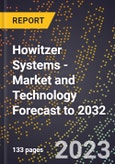The global Howitzer systems market is projected to grow with a 10.1% CAGR throughout the forecasted period, to reach a volume of US$72.1 billion. This big increase is partially explained by the war in Ukraine which has mainly impacted two of the largest markets, namely the North American and European. Europe is expected to account for 38.8% of the total market in the 2024-2032 period, with a volume of US$28.01 billion, marking a 9.3% CAGR.
The war in Ukraine has highlighted some of the key characteristics of the modern battlefield against a peer enemy. Long-range fires have always been in the plans of all armies, but there is an inherent conception that these would be better served with missile systems, which among other characteristics provide accuracy. While this is true the war in Ukraine has also highlighted the importance of volume of fire, which cannot be adequately served by missile systems.
The importance of volume in fires has remained at the centrepiece of Russian (and Chinese) tactical planning. These ground forces can deploy thousands of howitzers to dominate the battlefield and open the way for troops to seize their targets. Although that issue could be tackled by the acquisition of a proportionally if not equally large number of howitzers from the Western countries and their allies, the costs are prohibiting.
Joint procurement from security or political organizations’ member-states (e.g. the EU and NATO) could provide the organisational, legal, and financial framework to form economies of scale and reduce the impact of independent procurement and future support.
Nevertheless, the market is not only determined by pricing but political factors too. As in every major platform procurement political support is important to successfully close an agreement. Howitzer systems do not escape from that realm.
What is currently important also is the ability of industries to manufacture howitzer systems. The war in Ukraine has overstretched the industrial capacity. Despite the collective actions on behalf of the EU countries and the US, it is a challenging task that will require every production facility available to join the effort. Looking into that from a different angle, it can be said that opportunities are not only found in sales of the systems but also the form of M&A throughout the supply chain, with possible further consolidation opportunities being ahead.
Covered in this Study
- Overview: Snapshot of the Howitzer Systems technology in the military market during 2024-2032, including highlights of the demand drivers, trends, and challenges. It also provides a snapshot of the spending with respect to regions as well as segments and sheds light on the emergence of new technologies.
- Market Dynamics: Insights into the technological developments in the Howitzer Systems market and a detailed analysis of the changing preferences of governments around the world. It also analyses changing industry structure trends and the challenges faced by the industry participants.
- Segment Analysis: Insights into the various systems market from a segmental perspective and a detailed analysis of factors influencing the market for each segment.
- Regional Review: Insights into modernization patterns and budgetary allocation for top countries within a region.
- Regional Analysis: Insights into the systems market from a regional perspective and a detailed analysis of factors influencing the market for each region.
- Impact Analysis: Analysis of how certain events will impact the missiles market. This will give you an indication of which factors are important for the forecast.
- Key Program Analysis: Details of the top programs in each segment expected to be executed during the forecast period.
- Competitive landscape Analysis: Analysis of competitive landscape of this industry. It provides an overview of key companies, together with insights such as key alliances, strategic initiatives, and a SWOT analysis.
Segmentation
The publisher has segmented the Howitzer Systems market into three major groups. We've researched these major segments and provide forecast figures for 2024 - 2032. The segments are:
Region
- North America
- Asia Pacific
- Europe
- Middle East & Africa
- Latin America
Mobility
- Towed
- Tracked
- Wheeled
Calibre
- 105-149
- 150-200
Reasons to Buy
- Insight into the howitzer systems technologies, their organization in units, and employment on the battlefield.
- Understanding of the market in terms of demand drivers, industry trends, and the latest technological developments, which shape the market.
- Comparison of the advantages of howitzer systems based on their mobility (towed, tracked, or wheeled) which will provide the necessary arguments to manufacturers and business developers, when interacting with other stakeholders.
- In-depth understanding of other factors affecting the market such as defence spending, operational requirements and challenges faced by manufacturers, among several others.
- Outlining of the disruptions and the technology enablers impacting the market and how these could become an opportunity in this quickly changing domain.
- Identify opportunities available in the market.
Table of Contents
Companies Mentioned
- BAE Systems
- Elbit Systems
- Excalibur Army
- Hanwha Defense
- KNDS - KMW
- KNDS - Nexter
- Konstrukta Defense
- MKEK
- PGZ Group - HSW
- RBSL (Rheinmetall BAE Systems Land)
- Rheinmetall AG
- Yugoimport








